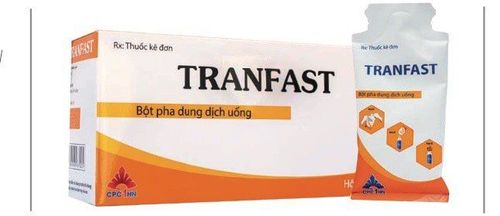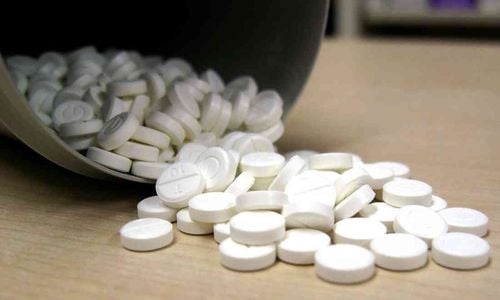This is an automatically translated article.
Uphatin is an over-the-counter medication used to treat constipation or before colonoscopy and colon surgery. To ensure effective use when using Uphatin, users need to follow the instructions of the doctor.
1. What are the effects of Uphatin?
1.1. What is Uphatin? Uphatin medicine has the main ingredient is Sodium picosulfate 5mg and excipients (White sugar, Gum Arabic, orange wine, Paraffin oil, orange essential oil, Talc, Magnesium Stearate).
Uphatin drug with registration number VD-17591-12, is a product of TW 25 Pharmaceutical Joint Stock Company, is prepared in the form of lozenges and packed in a box of 3 blisters, each blister has 10 tablets.
1.2. What does Uphatin treat? Ingredients Sodium picosulfate is a stimulant laxative like bisacodyl, used to treat constipation or to enema the colon before screening and colon surgery.
After oral administration, Uphatin drug is metabolized by intestinal bacteria, helping to stimulate intestinal motility. Metabolic products act on receptors in the intestinal wall, inhibiting water absorption from the intestinal lumen. This increases the volume of stools and stimulates peristalsis.
The effects of Uphatin usually appear after 10 to 14 hours. If used together with magnesium citrate for colon enema, the effect can appear after only 3 hours.
Sodium picosulfate is metabolized by intestinal bacteria to a still active substance, bis (p-hydroxyphenyl)-2-pyridymethane, and is excreted by the kidneys.
Indications for treatment:
Uphatin is indicated for:
Treatment of symptoms of constipation. Prepare for colonoscopy or surgery. Contraindications:
Contraindicated to use Uphatin in the following cases:
Patients with intestinal obstruction. Patients with abdominal pain without a confirmed diagnosis or suspected need urgent surgical intervention.
2. Usage of Uphatin
2.1. How to take Uphatin The patient holds Uphatin in his mouth. Time of use:
Treatment of constipation: Before going to bed. Bowel lavage: Morning and afternoon the day before the visit or surgery. 2.2. Dosage of Uphatin The dosage of Uphatin depends on the disease, age and health status of the patient as follows:
Treatment of constipation:
Adults and children over 10 years old: Take 1 to 3 tablets/time a day . Children from 2 to 5 years old: Take 1⁄2 tablets. Children from 5 to 10 years old: Take 1⁄2-1 tablet. Wash and remove intestines: Take 2 tablets at a time.
Dealing with missed doses:
Usually, Uphatin drugs can be taken within 1 to 2 hours compared to prescribed in the prescription. Unless there is a very strict rule about the time of use, the medicine can be taken after a few hours when it is detected. But, if the time is too far from the time when you need to take Uphatin, you should not take it because it may be dangerous to the body. It is necessary to strictly adhere to or consult a doctor before making a decision. Treatment of overdose:
Symptoms of an overdose of Uphatin include: Diarrhea, dehydration, electrolyte disturbances or even paralysis of the colon due to atony. If the patient accidentally overdoses on Uphatin and has adverse side effects, it is necessary to go to the nearest medical facility. Intravenous fluid and electrolyte replacement is usually used.
3. Note when using the drug Uphatin
Patients need to be careful when there is inflammation in the intestinal tract. Avoid prolonged use of Uphatin or overdose. Do not use sodium picosulfate and magnesium citrate when the patient has a dilated colon due to poisoning. Safety in pregnant women has not been established. Patients should not take Uphatin without the prescription of a doctor. Lactation: Uphatin is excreted in breast milk. If the mother is taking Uphatin, she should stop breastfeeding to ensure the safety of the baby. Uphatin does not affect the ability to drive or use machines. Therefore it is allowed to use in these objects.
4. Side effects of the drug Uphatin
Some of the possible side effects when taking Uphatin include:
Common: Colic pain, diarrhea and hypokalemia. Rare: External rash. If in the process of using Uphatin appear any adverse effects, please inform your doctor or qualified pharmacist to receive appropriate assistance.
5. Uphatin drug interactions
Drug interactions that need attention when used in combination with Uphatin include:
Drugs that cause torsade de pointes: Bepridil, Vincamine, Amiodarone and Sotalol. Digitalis: Due to hypokalemia may increase the toxicity of Digitalis. Corticosteroids and potassium-lowering diuretics: Risk of synergistic effects of hypokalemia. To ensure safety, avoid adverse interactions, it is necessary to inform your doctor about all medications you are taking.
In addition, consideration should be given to the use of Uphatin with alcohol, tobacco, alcoholic or fermented beverages. Factors that can change the composition of the drug. See details in the leaflet or consult your doctor or pharmacist for more details.
6. How to store Uphatin
The shelf life of Uphatin is 24 months from the date of manufacture. Store in a cool, dry place, at a temperature not exceeding 30°C, in the original packaging and protected from light, away from acidic environments. Keep Uphatin out of reach of children and pets. Before using, you should carefully check the expiry date of Uphatin. Never use after the expiry date printed on the package. The article has provided information on dosage, contraindications and notes during use and Uphatin therapeutic uses. To ensure that Uphatin works optimally and to prevent side effects, patients should consult their doctor/pharmacist before use.
Please dial HOTLINE for more information or register for an appointment HERE. Download MyVinmec app to make appointments faster and to manage your bookings easily.













